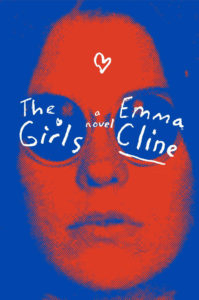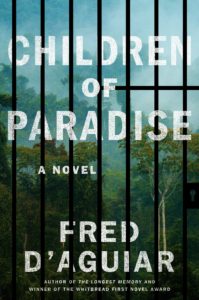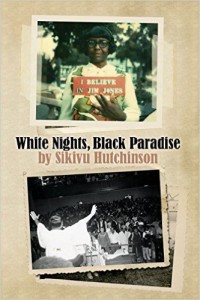(This review article is adapted from the original version which appeared in Litro Magazine, and is reprinted with permission.)
The Girls
Emma Cline
Random House, 368 pp, 2016
Children of Paradise: A Novel
Fred D’Aguiar
HarperCollins 384 pp, 2015
White Nights, Black Paradise
Sikivu Hutchinson
Infidel Books, paper 325 pp, 2015
Jonestown
Wilson Harris
Faber & Faber (UK) 1997
 Charlie Manson and his “family” provide the historical backdrop for Emma Cline’s first novel, The Girls, just published with a multimillion-dollar book deal for the white American author, born in 1989. Jim Jones and Peoples Temple serve as real-life fodder for fiction published last year by Guyanese-Canadian Fred D’Aguiar (reviewed on the front page of The New York Times Book Review) and a small press contribution by African-American Sikivu Hutchinson. Why do cults so fascinate the reading public, and why, when actual history begs one’s imagination with its rawness, does fiction carry such great weight in their portrayal?
Charlie Manson and his “family” provide the historical backdrop for Emma Cline’s first novel, The Girls, just published with a multimillion-dollar book deal for the white American author, born in 1989. Jim Jones and Peoples Temple serve as real-life fodder for fiction published last year by Guyanese-Canadian Fred D’Aguiar (reviewed on the front page of The New York Times Book Review) and a small press contribution by African-American Sikivu Hutchinson. Why do cults so fascinate the reading public, and why, when actual history begs one’s imagination with its rawness, does fiction carry such great weight in their portrayal?
In Cline’s new offering, the first-person protagonist offers the inside story of a 14-year-old girl in the late 1960s drawn to a charismatic older man, Russell, who plays bad guitar and attracts females like flies to offal, groups of them clustering in his wake. Cline also imparts the perspective of age, if not wisdom, as the contemporary story unfolds, a 50-something Evie looking back at her adolescence when confronted by unexpected young guests, including a teenaged girl who recalls her former self, in thrall to a bad boy/man.
* * * *
The Evie we meet on the first page is white, a child of money, bored at the beginning of a Northern California summer, lonely and more or less ignored by recently divorced parents, both of them with new partners, desperately seeking personal fulfillment while their only child languishes with too much freedom and zero responsibilities. The fictional Evie, who has no counterpart in the Manson story, allows the reader to pry inside the mind of an impressionable female who just might go so far as to join in a brutal mass killing. Then again, she might not.
All three novels have in common the desire to understand what the facts don’t sufficiently explain. In Manson’s story, well-heeled, intelligent females carve Xs in their foreheads and murder strangers for the man they worship. The followers of Jim Jones – nearly 1,000 Americans, a racially mixed group, one third elderly and another third children – either commit suicide voluntarily or are forced to ingest poison in a Guyanese jungle. Countless non-fiction books — covering genres from religious history to sociology to psychology and more – recount “what really happened” and attempt to impose order on the chaotic, murderous behavior of groups of twentieth century Americans. But “the truth” fails to satisfy.
Cline’s version, written in lucid, shining prose, allows us to inhabit the skin of a mostly passive teenager, dabbling in drugs and drink and wondering if sex will bring her into the adulthood she thinks she craves. Unfortunately, the first-person narrative, while most immediate of all points-of-view in fiction, works less well if the reader chafes inside that particular character’s skin.
As a child, I had once been part of a charity dog show and paraded around a pretty collie on a leash, a silk bandanna around its neck. How thrilled I’d been at the sanctioned performance: the way I went up to strangers and let them admire the dog, my smile as indulgent and constant as a salesgirl’s, and how vacant I’d felt when it was over, when no one needed to look at me anymore.
The above is the elder Evie reflecting on her childhood in a curious blend of nostalgia and angst. We don’t actually meet the grown-up Evie for the first 130 pages of the story. However, Evie’s wistfulness persists, whether she is 54 or 14; she never got what she was looking for, it seems, and a melancholy passivity suffuses the entire novel.
Further reflecting on that girl with the dog, Evie muses:
I waited to be told what was good about me. I wondered later if this was why there were so many more women than men at the ranch. All that time I had spent readying myself, the articles that taught me life was really just a waiting room until somebody noticed you – the boys had spent that time becoming themselves.
Waiting, in fact, is what Evie does most and what she does best. For readers impatient with such inertia, Evie’s tale, though always beautifully written, sinks into its lassitude.
 Children of Paradise, the first novel published by a Guyanese author in the United States to deal with Jones and Jonestown, launches itself into magical realism as it makes one of the key protagonists a gorilla, Adam, based on the chimpanzee Jones kept caged in the jungle. D’Aguiar speaks from the animal’s perspective, attempting to give the reader an entirely “other” perception of Jones and his mania. The two female characters, an African-American mother and daughter who bravely make the best of an impossible situation, where they are always hungry and fearful of the leader’s mood swings, allow us some insight into the ineffable. Two human beings who love one another, bear the burden of hope, though we suspect their story will not end well, as we know the brutal revelations of November 18, 1978, the 900+ bodies bloating beneath the equatorial sun.
Children of Paradise, the first novel published by a Guyanese author in the United States to deal with Jones and Jonestown, launches itself into magical realism as it makes one of the key protagonists a gorilla, Adam, based on the chimpanzee Jones kept caged in the jungle. D’Aguiar speaks from the animal’s perspective, attempting to give the reader an entirely “other” perception of Jones and his mania. The two female characters, an African-American mother and daughter who bravely make the best of an impossible situation, where they are always hungry and fearful of the leader’s mood swings, allow us some insight into the ineffable. Two human beings who love one another, bear the burden of hope, though we suspect their story will not end well, as we know the brutal revelations of November 18, 1978, the 900+ bodies bloating beneath the equatorial sun.
 Another approach entirely arrived in 1996 from the British-Guyanese author Wilson Harris, who is not primarily interested in the members of Peoples Temple who invaded his South American homeland. Wilson focuses on the people of Guyana and how the horror of Jonestown became yet another form of colonialism perpetrated on the people of this small country, once known as British Guiana and the world’s foremost exporter of bauxite. Profits accrued to the British, leaving most Guyanese impoverished, and the debacle of Jim Jones and his followers’ impact on the country similarly devastates the Guyanese. Like D’Aguiar, Wilson’s approach is through magical realism, which Wilson uses to impart the sensibility of the Guyanese characters in the novel; the Americans remain out of focus here, as they should.
Another approach entirely arrived in 1996 from the British-Guyanese author Wilson Harris, who is not primarily interested in the members of Peoples Temple who invaded his South American homeland. Wilson focuses on the people of Guyana and how the horror of Jonestown became yet another form of colonialism perpetrated on the people of this small country, once known as British Guiana and the world’s foremost exporter of bauxite. Profits accrued to the British, leaving most Guyanese impoverished, and the debacle of Jim Jones and his followers’ impact on the country similarly devastates the Guyanese. Like D’Aguiar, Wilson’s approach is through magical realism, which Wilson uses to impart the sensibility of the Guyanese characters in the novel; the Americans remain out of focus here, as they should.
* * * *
 Of all of these novels, it is the relatively unknown scholar of secular social justice Sikivu Hutchinson who manages best to present a simulacrum of life as it might have been in the jungle compound of Jonestown. Jones’s eponymously named village began in 1973 as Eden-in-exile, the Utopian strain of American history this time intertwined with the goal of ending racism, making an egalitarian paradise anew, forging a New World out of the jungle.
Of all of these novels, it is the relatively unknown scholar of secular social justice Sikivu Hutchinson who manages best to present a simulacrum of life as it might have been in the jungle compound of Jonestown. Jones’s eponymously named village began in 1973 as Eden-in-exile, the Utopian strain of American history this time intertwined with the goal of ending racism, making an egalitarian paradise anew, forging a New World out of the jungle.
Of course, it didn’t happen like that. The inner circle of Jones’s administrators is all white, with occasional black token figures. Jones, like Manson, had a predilection for sex with multiple partners, all of whom – with one exception – were white. Unlike Manson, Jones included men in his conquests, many of whom returned his favors with undying loyalty, including the Jewish doctor who mixed the cyanide-Flavor Aid concoction (not Kool Aid, as the phrase has come down to us in popular parlance).
Protagonist Taryn, who embodies the role of skeptic and seer, laments:
We’re the only ones dumb enough to leave the States en masse without a plan for a way back. In fact the government is probably saying to Jim, why can’t you take some more Negroes with you? While you’re at it, take all the ghettoes of Watts, Newark, Detroit and Harlem and dump them in Jonestown. What the fuck do we care about a bunch of spooks.
Perhaps Hutchinson’s novel carries more heft as a fictional depiction of an historical tragedy because her characters are stakeholders, invested and doomed, not passive onlookers. D’Aguiar’s characters are similarly involved, though the trope of the anthropomorphic Adam makes for difficult reading, the suspension of disbelief not possible. While Cline purposely chose a protagonist who did not participate in the fictional version of the Tate-La Bianca murders, her choice of leading character lent an air of avoidance rather than engagement with the grit and horror of the original story.
(Annie Dawid, the author of three volumes of fiction, has completed a novel of Jonestown entitled Resurrection City, which was one description of Jonestown in its early days, offered by a visiting journalist.
(In one form or another, the book has been a finalist in multiple contests through the summer of 2016. Among them: Black Lawrence Press (twice); Leapfrog Press (as “Jonestown Perfume, a collection of stories”); Elixir Press (twice); Faulkner Society Contest, (for the novel and a novella, “Mrs. Jim Jones: One Possible Biography”); Santa Fe Writer’s Project; GlimmerTrain Fiction Open (“Ten Days Before the End,”); Snake Nation Press, and Gold Line Press for the long story, “Jonestown: Thirty Years On.”
(Three short pieces of the book have been or are soon to be published: “Jonestown, Japantown” in the San Francisco edition of Joyland Magazine; “Jonestown: Thirty Years On,” in Best American Writing 2015; and “Knowing What I Know,” in Driftwood: A Literary Journal of Voices from Afar, 2006.
(Annie Dawid’s complete collection of articles for this site may be found here. She can be reached at annie@anniedawid.com.)